Skills Check
![]() Skills Check
Skills Check
Question 1.1
1. The accompanying graph has
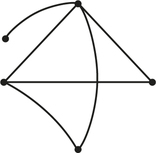
- four vertices and six edges.
- four vertices and four edges.
- five vertices and six edges.
1.
c
Question 1.2
2. The number of vertices in the following graph is ____, while the number of edges in this graph is ______.

2.
7; 9
24
Question 1.3
3. The accompanying graph
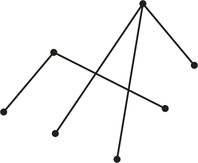
- is even-valent.
- is not connected.
- has six components.
3.
b
Question 1.4
4. The graph shown below is not connected because it consists of _______ parts.

4.
four
Question 1.5
5. What is the valence of vertex in the graph below?
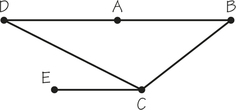
- 2
- 1
- 3
5.
a
Question 1.6
6. A graph has 24 edges and all the vertices of the graph have valence 3. The number of vertices of the graph must be ______.
6.
16
Question 1.7
7. The valences of the vertices in the accompanying graph, listed in decreasing order, are

- 6, 4, 3, 3, 3, 2, 1, 1, 1.
- 1, 3, 4, 4, 5, 5.
- 5, 5, 4, 3, 3, 1, 1, 1.
7.
a
Question 1.8
8. The alphabetically ordered list of even-valent vertices of the graph below is ______, ______.

8.
B; E
Question 1.9
9. Which of the statements about the accompanying graph is false?
- It is connected.
- It is not a graph because it includes curved edges.
- It is even-valent.

9.
c
Question 1.10
10. The accompanying graph has _____ edges and ______ vertices.

10.
8; 7
25
Question 1.11
11. Which of the following statements about a path is true?
- A path always forms a circuit.
- A path is always connected.
- A path can visit any vertex only once.
11.
b
Question 1.12
12. A graph G has 10 edges, and all its vertices have the same valence. The possible valences of the vertices of G are _____, _____, _____, _____, _____.
12.
1; 2; 4; 5; 10
Question 1.13
13. It is not possible for a graph to have three vertices of valence 3 and six vertices of valence 4 because
- there are no graphs with exactly 11 vertices.
- a graph cannot have an even number of 4-valent vertices.
- a graph cannot have an odd number of odd-valent vertices.
13.
c
Question 1.14
14. If a graph consists of five vertices and every pair of vertices is connected by a single edge, the number of edges in the graph is exactly _______.
14.
10
Question 1.15
15. For which of the situations below is it most desirable to find an Euler circuit or an efficient eulerization of the graph?
- Sweeping the sidewalks of a small town
- Planning a new highway
- Planning a parade route in Muncie, Indiana
15.
a
Question 1.16
16. For the accompanying graph, the vertex that has the largest valence is _______, and the number of edges in the graph is _______.
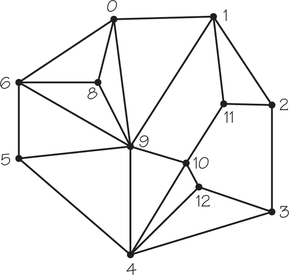
16.
9; 23
Question 1.17
17. The following graph has no Euler circuit because it

- is even-valent.
- has seven vertices.
- is not connected.
17.
c
Question 1.18
18. If a graph is connected and has nine vertices, the graph must have at least _______ edges.
18.
8
Question 1.19
19. Consider the path represented by the sequence of numbered edges on the graph below. Which statement is correct?
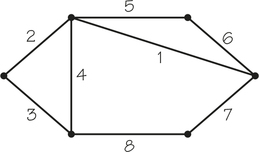
- The sequence of numbered edges forms an Euler circuit.
- The sequence of numbered edges forms a circuit but not an Euler circuit.
- The sequence of numbered edges traverses each edge exactly once but is not an Euler circuit.
19.
c
Question 1.20
20. The accompanying graph has no Euler circuit because it
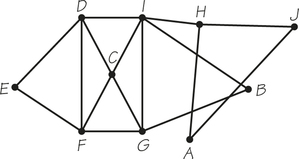
- is not even-valent.
- has 16 edges.
- is not connected.
20.
a
26
Question 1.21
21. The minimum number of edges that must be duplicated to create a best possible eulerization of the following graph is ______.
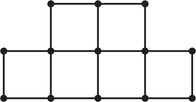
21.
4
Question 1.22
22. For the accompanying graph, the minimum total number of edges which constitutes a tour of the graph, starting and ending at the same vertex, and which visits each edge at least once, is _______.
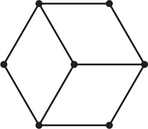
22.
12
Question 1.23
23. Suppose each vertex of a graph represents a baseball team and each edge represents a game played by two baseball teams. If the resulting graph is not connected, which of the following statements must be true?
- At least one pair of teams never played a game.
- At least one team played every other team.
- The teams play in distinct leagues.
23.
a
Question 1.24
24. If a graph has eight vertices of odd valence, the absolute minimum number of edges that must be added (duplicated) to eulerize the graph is ______.
24.
4
Question 1.25
25. Suppose the edges of a graph represent streets that must be salted after a snowstorm. To eulerize the graph, four edges must be added. The real-world interpretation of this is that
- four streets will be traversed twice.
- four streets will not be salted.
- four new streets would be built.
25.
a
Question 1.26
26. For each of the following situations, decide whether a graph or a digraph seems a more reasonable model.
- A system of hiking trails: ___________
- A bus route map: ___________
- An electrical wiring plan for a home: _________
26.
digraph; digraph; graph
Question 1.27
27. The smallest number of edges needed to eulerize the graph below is
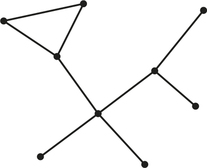
- 4.
- 6.
- 8.
27.
b
Question 1.28
28. If the valences of the vertices of a graph G are: 5, 4, 4, 4, 4, 3, 2, 2, and 2, the number of vertices of G is _______ and the number of edges of G is _______.
28.
9; 15
Question 1.29
29. The smallest number of edges that must be added to the accompanying graph for it to have an Euler circuit is
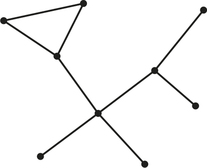
- 3.
- 6.
- 7.
29.
a
Question 1.30
30. The number of edges in a Chinese postman tour (i.e., a tour with a minimum number of edges that starts and ends at the same vertex and visits each edge at least once) for the accompanying graph is ________.
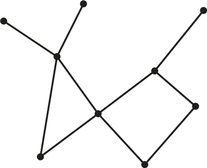
30.
13